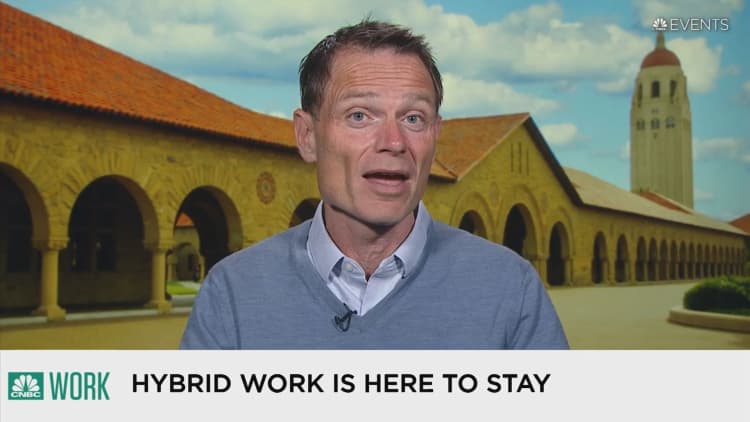Hybrid work is the new normal, as companies rethink work habits and office and retail space
2 min read

Virojt Changyencham | Moment | Getty Images
Office demand declines
That flexibility is helping drive down demand for office space. By 2030, McKinsey predicts, demand for office space will be as much as 20% lower than it was in 2019, depending on the city. While remote and hybrid work is the big reason, the trend toward more desks in less space and shifts to automation were also factored into its analysis.
Lower office space demand has companies rethinking how to make their real estate jibe with new work habits. Working in teams and increasing productivity are the top reasons office workers with flexibility give for being on-site.
Many office environments are not meeting employees’ needs. Having spaces for employees that are free from noise and distraction so they can work independently is “critical to job performance,” says Jordan Goldstein, a managing principal at architecture firm Gensler.
Creating what’s called “meeting equity” is also important, so people who are physically in the office and people who are working remotely can conduct business. “The days of a four- to six-person room with a 42-inch flat screen on the wall are over,” said Goldstein. Instead, he suggests employers should create an environment where the virtual and physical offices are brought together.
The ripple effect: People moving out
The evolution in office culture has also changed where people are choosing to live. Of the people surveyed who moved after March 2020, 20% said that their move was possible only because they could now work from home more frequently, according to McKinsey.
Researchers looked at neighborhoods in San Francisco, Houston and the borough of Manhattan in New York, and found people moved out of expensive, office-dense ZIP codes and into cheaper ones with more mixed use of real estate.
McKinsey’s comparison of the pandemic’s effect on New York’s Financial District and Lower East Side neighborhood showed that mixed-use neighborhoods, with a diverse offering of office, residential and retail space fared the best.
The Financial District, which consists of 80% office real estate, a large concentration of workers and an average home price of about $1.5 million saw people leave at more than two times the rate than the Lower East Side, where the average home price is about $500,000 lower and just 7% of real estate is dedicated to office space.
Retail demand is changing
Shopping patterns were also changed by the pandemic, with remote and hybrid workers less likely to spend near the office.
“Retailers need to rethink their model,” said Jan Mischke, a partner at the McKinsey Global Institute, as foot traffic and and spending continues to be lower — especially in office-dense neighborhoods — and online shopping continues to take market share from stores. “The demand for retail floorspace in 2030 will be lower than it than it [was] in 2019,” he said.
“We feel we have a sufficient clarity now that it’s relatively clear what needs to happen,” said Mischke. At the city level, that means creating more mixed-use environments, which proved more resilient during the pandemic.







